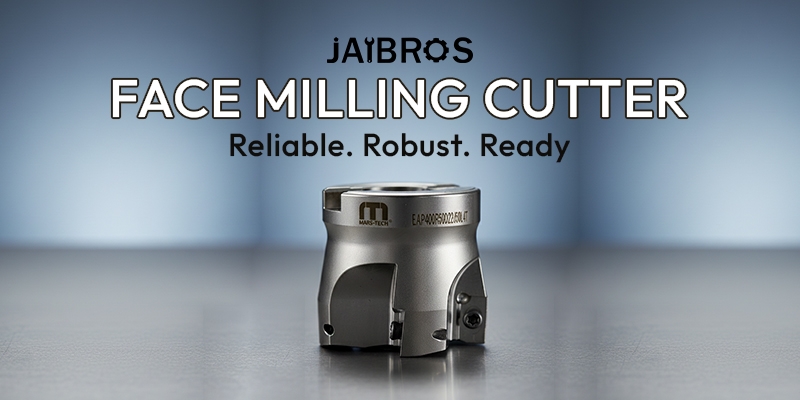In every workshop, Learn how a face milling cutter helps create flat, smooth surfaces with high precision in CNC and milling machines used across various industries.
What Is a Face Milling Cutter?
A face milling cutter is a multi-edge or insert rotating tool for milling. These inserts, commonly constructed of carbide or other sturdy materials, can easily cut hard metals. The cutter, affixed to the spindle of the milling machine, rotates at a high speed, removing small layers of material from the surface of the workpiece using the inserts on its face.
There are many sizes and configurations of face milling cutters depending upon the work type and finishing requirements. Some cutters allow for the changing of the inserts, while other cutters use a solid one-piece construction.
Types of Face Milling Cutters
-
Shell Mill Cutters – These cutters have replaceable inserts attached to the main body. They are cost-effective because you can replace the inserts instead of the entire cutter.
-
Solid Face Mills – Made from a single block of material, these cutters are used for smaller jobs and softer metals.
-
Indexable Face Mills – These have carbide inserts that can be indexed or rotated to use a new edge. This type is common in modern CNC workshops.
-
High-Speed Steel Cutters – Used for lighter jobs and soft materials where less cutting pressure is needed.
Each type has its own advantage depending on the job material and surface requirement.
Materials Used in Face Milling Cutters
The material of the face milling cutter depends on the application. Common materials include:
-
Carbide – Known for its hardness and durability, it is suitable for cutting tough materials like steel.
-
High-Speed Steel (HSS) – Cheaper option, good for soft metals.
-
Cermet and Ceramic Inserts – Used for high-speed finishing operations where surface quality is most important.
-
Coated Tools – These cutters have a thin layer of coating (like TiN or TiAlN) that improves heat resistance and lifespan.
Advantages of Using Face Milling Cutters
-
High Precision – They provide a flat, accurate surface finish.
-
Faster Material Removal – Ideal for machining large surfaces quickly.
-
Better Tool Life – Indexable inserts allow multiple cutting edges to be used before replacement.
-
Cost-Effective – Only the inserts need replacement, not the whole tool.
-
Versatile Use – Can be used on different metals like steel, aluminum, cast iron, and more.
How to Use a Face Milling Cutter
Using a face milling cutter properly ensures good results and longer tool life. Here are the basic steps:
-
Setup the Machine – Mount the cutter on the milling spindle and ensure it is fixed tightly.
-
Select Proper Speed and Feed – Adjust cutting speed and feed rate according to material type.
-
Use Coolant – Apply coolant or lubrication to prevent overheating and to get a smooth surface finish.
-
Cut in Multiple Passes – Don’t remove too much material in one go; work in light passes for better accuracy.
-
Check Surface Finish – After cutting, check the surface with a gauge to ensure evenness.
Proper usage reduces vibration, increases cutting efficiency, and extends tool life.
Where Face Milling Cutters Are Used
Face milling cutters are widely used in various industries and applications:
-
Automotive Industry – For machining engine blocks, gear housings, and flat metal surfaces.
-
Aerospace Industry – Used to shape aircraft components made from aluminum and titanium.
-
Tool and Die Making – Helps in achieving smooth and accurate surface finishes on molds and dies.
-
General Metalworking – Suitable for flat-surface finishing in workshops and CNC setups.
Whether in large-scale factories or small workshops, this tool is a must-have for precision machining.
Maintenance and Care Tips
Taking care of your cutter ensures better performance and longer life:
-
Clean the cutter after each use.
-
Check for wear or cracks on inserts regularly.
-
Replace dull inserts immediately.
-
Store in a dry place to avoid rust.
-
Use the correct torque when mounting inserts.
Simple maintenance practices can save time and money in the long run.
Why Choose Quality Cutters from Trusted Sources
There are numerous factors to consider when buying a face milling cutter including quality, size, and form. A good quality face mill cutter works better and provides a smooth finish that allows for tool life expectancy operating at high cutting speeds. Jaibros is a trusted supplier of CNC machine tool and accessories with quality products with durable face mill cutters that can be used in all various cutting jobs. Purchase of face mill cutters or other accessories from reputable suppliers can help you feel confident about the safety , efficacy and efficiency of your workshop work.
Conclusion
In the field of machining, the face milling cutter is another essential tool for making accurate, flat surfaces. It excels in high production, speed, durability, and superior finish quality that makes a face milling cutter one of the preferred tools for CNC and manual milling applications. With adequate use and maintenance, along with the appropriate cutter selection, consistent outputs and productivity gains can be achieved in any machine shop.
FAQs
1. What is the use of a face milling cutter?
It is used to make flat and smooth surfaces on metal workpieces.
2. What materials can be machined with a face milling cutter?
Steel, aluminum, cast iron, and other hard metals.
3. Are the inserts in face milling cutters replaceable?
Yes, most cutters have replaceable carbide inserts.
4. How to improve the tool life of a face milling cutter?
Use the correct cutting speed, proper coolant, and regular cleaning.
5. Where can I buy a face milling cutter online?
You can buy them from trusted industrial suppliers like Jaibros.com, known for quality machine tools.






